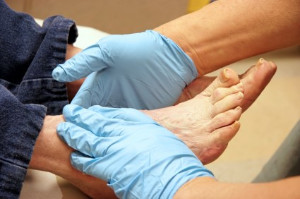Blog
Items filtered by date: May 2022
Excessive Foot Sweat

Focal hyperhidrosis is when the palms of the hands or soles of the feet sweat excessively. This condition can be inherited, be due to an underlying health problem (such as menopause, obesity, or diabetes), be a side effect of medications, or have no known cause. Though not serious itself, hyperhidrosis can lead to other uncomfortable skin problems or infections and can cause anxiety and embarrassment. This condition usually starts in adolescence. Clammy or wet soles of the feet can be reduced by wearing footwear made of natural materials, like leather, wearing moisture absorbing socks, and using foot antiperspirants. People who suffer from hyperhidrosis may be afraid to seek help or may not know that several other treatment options exist. Consulting with a podiatrist will help you identify if there is a possible underlying cause for this problem, and to assist you with obtaining a more effective treatment plan.
If you are suffering from hyperhidrosis contact one of our doctors of Kitsap Foot & Ankle Clinic. Our doctors can provide the care you need to attend to all of your foot and ankle needs.
Hyperhidrosis of the Feet
Hyperhidrosis is a rare disorder that can cause people to have excessive sweating of their feet. This can usually occur all on its own without rigorous activity involved. People who suffer from hyperhidrosis may also experience sweaty palms.
Although it is said that sweating is a healthy process meant to cool down the body temperature and to maintain a proper internal temperature, hyperhidrosis may prove to be a huge hindrance on a person’s everyday life.
Plantar hyperhidrosis is considered to be the main form of hyperhidrosis. Secondary hyperhidrosis can refer to sweating that occurs in areas other than the feet or hands and armpits. Often this may be a sign of it being related to another medical condition such as menopause, hyperthyroidism and even Parkinson’s disease.
In order to alleviate this condition, it is important to see your doctor so that they may prescribe the necessary medications so that you can begin to live a normal life again. If this is left untreated, it is said that it will persist throughout an individual’s life.
A last resort approach would be surgery, but it is best to speak with your doctor to find out what may be the best treatment for you.
If you have any questions please feel free to contact one of our offices located in Bremerton and Port Orchard, WA . We offer the newest diagnostic and treatment technologies for all your foot and ankle needs.
Difficulty Walking and Gait Abnormality

Walking is an activity that as soon as we learn how to do it, we take it for granted. However, sometimes walking can become difficult because of age, illness, injury, or other factors. Symptoms that may develop are shooting pain, numbness and tingling, stiffness, imbalance, weakness, and limping. Types of gait abnormalities include walking with your head and neck pushed forward, walking with legs bent inward, dragging the feet while walking, waddling from side to side, and toes scraping the ground with each step. Among the many causes that can affect your gait are nerve damage, improper alignment of the body, lack of muscle strength and flexibility, inflammatory diseases and conditions, autoimmune deficiencies, injury, and stroke. If you notice an increased difficulty walking and are experiencing any of the symptoms listed above, please consult a podiatrist who can conduct a complete examination and offer an appropriate treatment plan.
If you have any concerns about your feet, contact one of our doctors from Kitsap Foot & Ankle Clinic. Our doctors can provide the care you need to keep you pain-free and on your feet.
Biomechanics in Podiatry
Podiatric biomechanics is a particular sector of specialty podiatry with licensed practitioners who are trained to diagnose and treat conditions affecting the foot, ankle and lower leg. Biomechanics deals with the forces that act against the body, causing an interference with the biological structures. It focuses on the movement of the ankle, the foot and the forces that interact with them.
A History of Biomechanics
- Biomechanics dates back to the BC era in Egypt where evidence of professional foot care has been recorded.
- In 1974, biomechanics gained a higher profile from the studies of Merton Root, who claimed that by changing or controlling the forces between the ankle and the foot, corrections or conditions could be implemented to gain strength and coordination in the area.
Modern technological improvements are based on past theories and therapeutic processes that provide a better understanding of podiatric concepts for biomechanics. Computers can provide accurate information about the forces and patterns of the feet and lower legs.
Understanding biomechanics of the feet can help improve and eliminate pain, stopping further stress to the foot.
If you have any questions please feel free to contact one of our offices located in Bremerton and Port Orchard, WA . We offer the newest diagnostic and treatment technologies for all your foot and ankle needs.
Wounds That Don't Heal Need to Be Checked
Children and Stress Fractures

A tiny crack in the bone is known as a stress fracture. It generally develops as a result of repetitive pressure that can come from participating in running and jumping activities. If you see your child limping or choosing not to take part in these types of activities, this may indicate a stress fracture. Some of the symptoms typically associated with this condition include swelling, pain, and tenderness when touched. Some children may endure this type of fracture from nutritional deficiencies or fragile bones. It is suggested that the activity that caused the stress fracture be temporarily stopped, which gives the foot a chance to heal. Additionally, many children wear a boot or cast, which can be helpful in providing stability as the healing process occurs. If you think your child has developed a stress fracture, it is strongly suggested that you speak with a podiatrist as quickly as possible to discuss correct treatment options with you.
Stress fractures occur when there is a tiny crack within a bone. To learn more, contact one of our doctors from Kitsap Foot & Ankle Clinic. Our doctors can provide the care you need to keep you pain free and on your feet.
How Are They Caused?
Stress fractures are the result of repetitive force being placed on the bone. Since the lower leg and feet often carry most of the body’s weight, stress fractures are likely to occur in these areas. If you rush into a new exercise, you are more likely to develop a stress fracture since you are starting too much, too soon. Pain resulting from stress fractures may go unnoticed at first, however it may start to worsen over time.
Risk Factors
- Gender – They are more commonly found in women compared to men.
- Foot Problems – People with unusual arches in their feet are more likely to develop stress fractures.
- Certain Sports – Dancers, gymnasts, tennis players, runners, and basketball players are more likely to develop stress fractures.
- Lack of Nutrients – A lack of vitamin D and calcium may weaken the bones and make you more prone to stress fractures
- Weak Bones – Osteoporosis can weaken the bones therefore resulting in stress fractures
Stress fractures do not always heal properly, so it is important that you seek help from a podiatrist if you suspect you may have one. Ignoring your stress fracture may cause it to worsen, and you may develop chronic pain as well as additional fractures.
If you have any questions, please feel free to contact one of our offices located in Bremerton and Port Orchard, WA . We offer the newest diagnostic and treatment technologies for all your foot care needs.
Simple Methods to Care for Diabetic Feet

There are many diabetic patients who understand that keeping their glucose levels in a normal range is essential in preventing painful foot conditions. The inability to feel sensations in the feet is referred to as neuropathy, and it is important to check for cuts, bruises and scrapes every day. This can be done by using a mirror, or by having a family member inspect the feet. Additionally, the feet will feel better when they are kept clean and dry, and it may help to use talcum powder between the toes. The painful condition that is known as cracked heels may be avoided when a good moisturizer is used. Many diabetic patients see a podiatrist to have their nails trimmed correctly, and this may help to prevent ingrown toenails. It is advised against walking barefoot, and wearing shoes that fit properly will make the feet and overall body feel more comfortable. If you are diabetic, it is strongly suggested that you are under the care of a podiatrist who can help you with managing your diabetic foot care..
Diabetic foot care is important in preventing foot ailments such as ulcers. If you are suffering from diabetes or have any other concerns about your feet, contact one of our doctors from Kitsap Foot & Ankle Clinic. Our doctors can provide the care you need to keep you pain-free and on your feet.
Diabetic Foot Care
Diabetes affects millions of people every year. The condition can damage blood vessels in many parts of the body, especially the feet. Because of this, taking care of your feet is essential if you have diabetes, and having a podiatrist help monitor your foot health is highly recommended.
The Importance of Caring for Your Feet
- Routinely inspect your feet for bruises or sores.
- Wear socks that fit your feet comfortably.
- Wear comfortable shoes that provide adequate support.
Patients with diabetes should have their doctor monitor their blood levels, as blood sugar levels play such a huge role in diabetic care. Monitoring these levels on a regular basis is highly advised.
It is always best to inform your healthcare professional of any concerns you may have regarding your feet, especially for diabetic patients. Early treatment and routine foot examinations are keys to maintaining proper health, especially because severe complications can arise if proper treatment is not applied.
If you have any questions please feel free to contact one of our offices located in Bremerton and Port Orchard, WA . We offer the newest diagnostic and treatment technologies for all your foot and ankle needs.
Vascular Foot Testing with Diabetes

When a person has diabetes, it is important to have annual foot checks, which might include vascular and possibly other testing of the feet. Neuropathy is a common complication of diabetes that interferes with feeling in the feet. This can lead to undetected foot sores or ulcers that are left untreated and can lead to foot amputation. A qualified podiatrist will palpate the Dorsal Pedis and Posterior Tibial arteries looking for pulses, review the skin quality, and check capillaries. Things like hair loss, thin, smooth, shiny skin, thick, brittle nails, and tapering toes are noted as they might indicate changes in artery function. Fissuring, particularly in the heels and oedema are checked as these may indicate “ischaemia” or buildup or blockage in the arteries. Diabetics can take action to protect their feet from vascular issues by wearing properly fitting shoes and socks, regular exercise, taking medications as prescribed, and weight management. Regular visits to a podiatrist should be scheduled to stay on top of foot health of diabetics.
Vascular testing plays an important part in diagnosing disease like peripheral artery disease. If you have symptoms of peripheral artery disease, or diabetes, consult with one of our doctors from Kitsap Foot & Ankle Clinic. Our doctors will assess your condition and provide you with quality foot and ankle treatment.
What Is Vascular Testing?
Vascular testing checks for how well blood circulation is in the veins and arteries. This is most often done to determine and treat a patient for peripheral artery disease (PAD), stroke, and aneurysms. Podiatrists utilize vascular testing when a patient has symptoms of PAD or if they believe they might. If a patient has diabetes, a podiatrist may determine a vascular test to be prudent to check for poor blood circulation.
How Is it Conducted?
Most forms of vascular testing are non-invasive. Podiatrists will first conduct a visual inspection for any wounds, discoloration, and any abnormal signs prior to a vascular test.
The most common tests include:
- Ankle-Brachial Index (ABI) examination
- Doppler examination
- Pedal pulses
These tests are safe, painless, and easy to do. Once finished, the podiatrist can then provide a diagnosis and the best course for treatment.
If you have any questions, please feel free to contact one of our offices located in Bremerton and Port Orchard, WA . We offer the newest diagnostic and treatment technologies for all your foot care needs.

